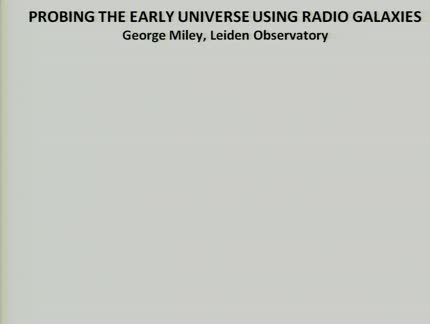Found 24 talks width keyword early universe

Abstract
In this talk, I will cover our contribution to the study of extremely red galaxy (ERG) populations presenting a multi-wavelength analysis of these objects, selected in the GOODS-South/Chandra Deep Field South field. By using all the photometric (from X-rays to radio) and spectroscopic information available on large deep samples of extremely red objects (EROs, 645 sources), infrared EROs (IEROs, 294 sources) and distant red galaxies (DRGs, 350 sources), we derive redshift distributions, identify AGN powered and star-formation powered galaxies (based on X-ray properties and a new IR AGN diagnostic developed by us), and, using the radio observations of this field, estimate robust (AGN- and dust-unbiased) star formation rate densities (SFRD) for these populations. Applying a redshift separation (1 ≤ z < 2 and 2 ≤ z ≤ 3) we find a significant rise (a factor of 1.5 — 3) of SFRD for EROs and DRGs toward high-z, while none is observed for IEROs. As expected, we find a significant overlap between the ERG populations, and investigate the properties of "pure" (galaxies that conform to only one of the three considered ERG criteria) and "combined" (galaxies conforming to all three criteria) sub-populations. We find ERG sub-populations with no AGN activity and intense star-formation rates. With average values of ~180 M⊙/yr at 2 ≤ z < 3, they reasonably contribute to the global star-formation rate density, reaching a > 20% level. Strong AGN behaviour is not observed in the ERG population, with AGN only increasing the average radio luminosity of ERGs by 10 — 20%. However, AGN are frequently found (in up to 27% of the ERG population), and would increase the SFRD estimate by over 100%. Thus, and while the contribution of SF processes to the radio luminosity in galaxies with AGN remains uncertain, a comprehensive identification of AGN in these populations is necessary to obtain meaningful results. The dust content to each population is also derived by correlating UV and Radio SFRs, giving a higher obscuration for more active SF sources. Also, know to be amongst the most massive galaxies in the high-z universe, I will show that ERGs may constitute up to 60% of the total mass in the universe at 1 ≤ z ≤ 3. Finally, preliminary and promising results are presented on the morphologies of ERGs (CAS and Gini/M20 parameters) based on the v1.9 ACS GOODS-S images.
Abstract
A Friedman-like cosmological model, based on noncommutative geometry, is presented. Its Planck level is totally nonlocal with no space and no time. The dynamics on this level is strongly probabilistic which makes the initial singularity statistically insignificant. Space, time and the standard dynamics emerge when one goes from the non-commutative regime (on the Planck level) to the usual "commutative physics".

Abstract
Luminous high-redshift radio galaxies (HzRGs) are associated with the most massive known galaxies in the early Universe. These galaxies have the properties expected of the progenitors of dominant galaxies in rich clusters.
I shall describe the properties of HzRGs and demonstrate how they can be used to study the formation and evolution of galaxies and clusters. I shall also show how LOFAR, the new European radio telescope, can be used to extend these probes into the epoch of reionisation.

Abstract
Since its discovery in 1964, the cosmic microwave background (CMB) has been one of the basic pillars of the cosmological model. However, it is only very recently that CMB observations have become one of the most powerful tools in modern cosmology, due to the increasing accuracy of the experiments measuring the CMB anisotropies. In this talk, I will present a brief historical perspective of the history of the CMB observations, since the discovery until nowadays, with special emphasis on the implications and the impact of those observations in cosmology. Experiments like COBE, Tenerife, WMAP or PLANCK will be described. The last part of my talk will be devoted to describe the future of this field, and in particular, will be focused on the possibility of the detection of primordial gravitational-waves.<< First « Newer 1 | 2 | 3 Older »
Upcoming talks
- Classical Be stars - Constraining binary interaction physics in massive starsDr. Julia BodensteinerThursday April 25, 2024 - 10:30 GMT+1 (Aula)
- Runaway O and Be stars found using Gaia DR3, new stellar bow shocks and search for binariesMar Carretero CastrilloTuesday April 30, 2024 - 12:30 GMT+1 (Aula)









